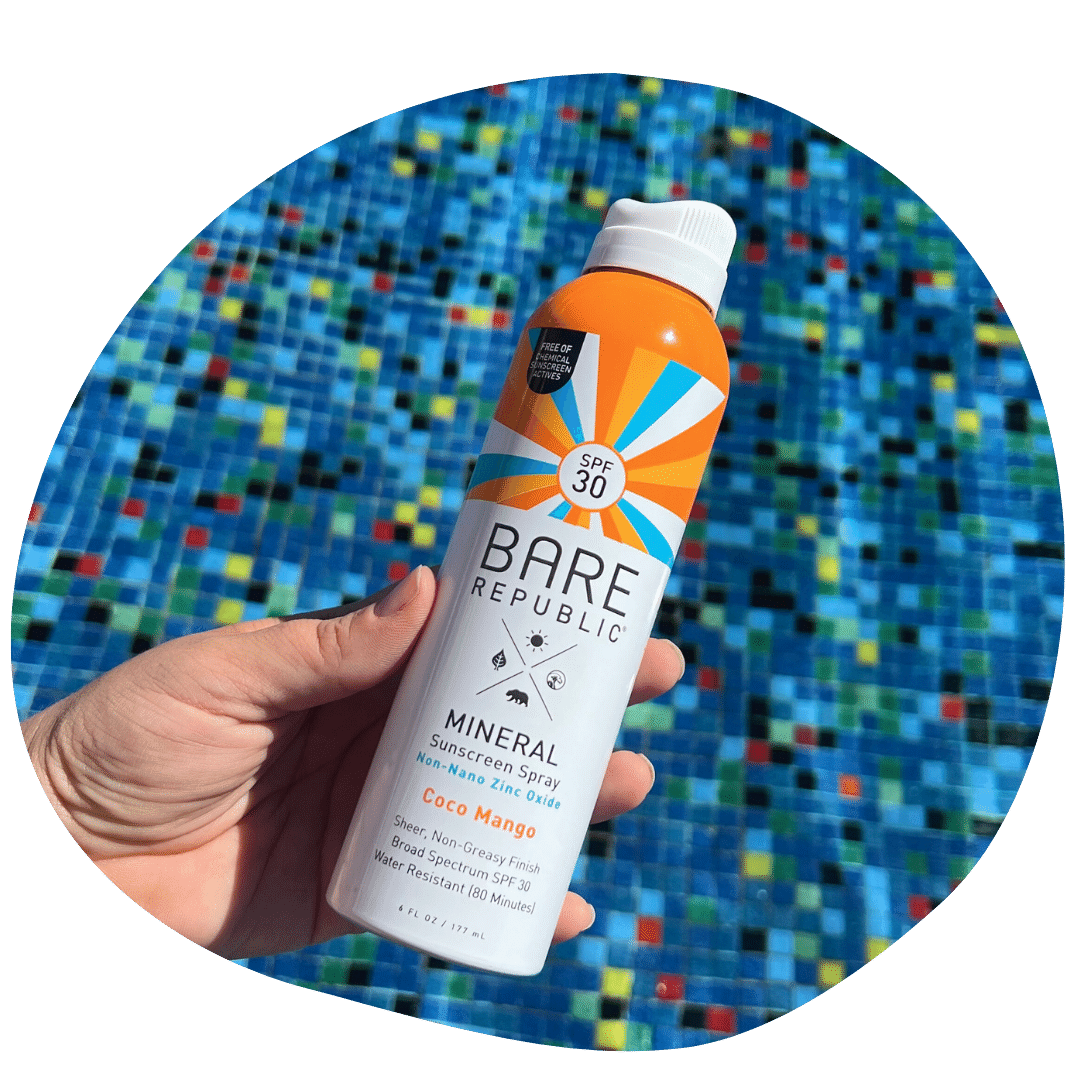
Best Approved Reef Safe Sunscreen to pack for Hawaii
Since we’re big fans of the ocean and spending long days at the beach, ensuring we have sunscreen and sun protection is essential, especially in Hawaii. Throughout the years we have been on the search for the best sunscreen, and have found some brands we do love. We’ve practically gone through pounds of sunscreen because […]
saltyvagabonds
Destinations
Travel Tips
Planning
About us
Saltyvagabonds
If you click on links we provide, we may receive compensation.
Since we’re big fans of the ocean and spending long days at the beach, ensuring we have sunscreen and sun protection is essential, especially in Hawaii. Throughout the years we have been on the search for the best sunscreen, and have found some brands we do love.
We’ve practically gone through pounds of sunscreen because we live on our sailboat between our travels. We have tried just about every popular sunscreen brands product so we can’t wait to share the types of sunscreen we purchase and why. Even though it’s truly best not to wear any when swimming in the ocean… I couldn’t imagine making it all the way there to then have your hawaiian vacation ruined by getting too much sun the first day.
Not wearing sunscreen though can cause some major sun damage. I have personally had two family members die from Melanoma skin cancer. It’s scary and important to still find the right balance of protecting yourself while also protecting the ocean.
Sadly, losing family members to skin cancer has affected me enough to do a research paper on melanoma in high school. Our top priority is always shielding human skin from harmful UV rays. Right behind that, safeguarding the coral reefs and marine life takes a close second spot on our list.
In this blog post we’ll explain what the Hawaii Reef compliant act 104 is and how the local Hawaiian government is trying to save the reefs from coral bleaching. Also, we’ll get into explaining the different sunscreens we have used and tell you the brand we currently use and carry with us.
The legalities of the Hawaii sunscreen ban
What is the The Hawaii Reef Compliant Act 104 and how did this reef compliant act come into effect in the State of Hawaii?
We believe that Hawaii was witnessing the issues that has been occurring in other parts of the world like The Great Barrier Reef in Australia and The United States Virgin Islands. There was a study published in 2015 called “Toxicopathological Effects of the Sunscreen UV Filter, Oxybenzone (Benzophenone-3), on Coral Planulae and Cultured Primary Cells and Its Environmental Contamination in Hawaii and the U.S. Virgin Islands”.
This study focused on the two toxic chemicals that are the active ingredient in chemical sunscreens, Hawaii banned in the Reef Compliant Act 104. The new Hawaiian islands sunscreen law banned the sale of sunscreens, distribution and possession of sunscreens with harmful chemicals oxybenzone and octinoxate.
The new law was signed during 2018 and went into effect on January 1, 2021. On this day Hawaii became the first state to ban these two elements in traditional sunscreen being sold in the state. The bill claims the “purpose of this Act is to preserve marine ecosystems, including coral reefs”.
The Bill also states “xybenzone and octinoxate can cause mortality in developing coral; increase coral bleaching that indicates extreme stress, even at temperatures below 87.8 degrees Fahrenheit; and cause genetic damage to coral and other marine organisms”.
Our real life learning experience with Coral Gardeners and coral bleaching.
On our travels to Moorea we learned about an organization called Coral Gardeners. We visited their headquarters on the island of Moorea. They explained there mission:
“We are on a mission to revolutionize ocean conservation and create a global movement to save the world’s coral reefs through active reef restoration, awareness activities and innovative solutions, developed by our CG labs”

We enjoyed the education on coral reefs and how the elements in sunscreen damage them. Sunscreens have been found to cause bleaching, damage, and deform DNA from young corals. Some sunscreen even kills corals.
The biggest thing we did learn was that all sunscreens can damage corals. Yes all, they did educate us that the sunscreens that are mineral based and missing the two main ingredients xybenzone and octinoxate are less damaging to the coral reefs.
If you and your family want to be 100% safe while at the reef it is best to not wear any sunscreen at all. You’ll hear from activists to instead use sun-safe long sleeve protective clothing to protect the reef. There’s a huge emphasis on avoiding the use of sunscreens, lotions, or other topical skincare products, completely because this truly is the best method to protect marine life. But if you’re also trying to save yourself from the sun’s harmful rays then wearing a good sunscreen is still going to be super important. We get that!
The best reef-safe sunscreens & reef-friendly sunscreens we have tried
On our journey to finding the best sunblock, we look for the best sunscreen with a wide uv spectrum including UVB rays, UVA rays, a less cakey feeling and needs to be mineral based for the active ingredients. We try to find vegan and organic ingredients in sunscreens at our local store.
Amanda is super into essential oils and their benefits so we try to find a mineral formula that also incorporates them too.
Manda Organic Sun Creme and Manda Organic Sun Paste Organic
We love MANDA for a variety of reasons. The main one is the name! Other reasons include the use of a not so common ingredient known as Thanaka. “Thanaka has been used for over 2000 years as a natural sun protectant that preserves and beautifies the skin” according to MANDA. The natural ingredients interested her and we have used it ever since.
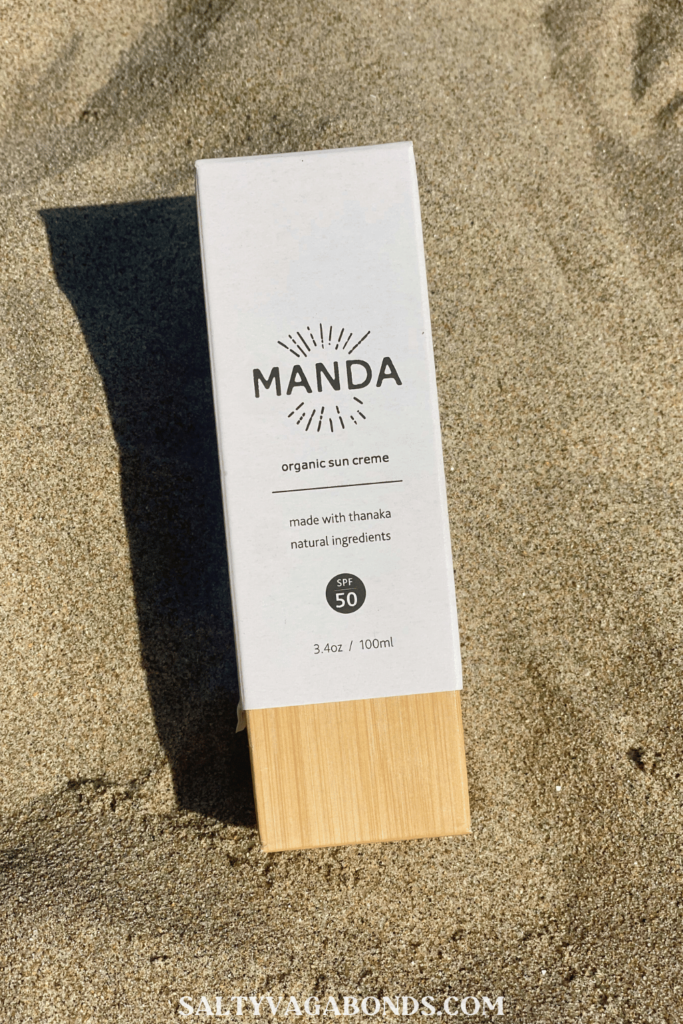
It feels like a light lotion and goes on smooth and silky. It does tend to have a yellowish tint because of the Thanaka. The packaging is 100% recyclable and made from cane sugar for the squeeze tube. The Manda organic sun paste is the only product we have found that includes a mirror on the bottom side of the cap to the jar.
Native Sunscreen
We originally found the Native Sunscreen brand at Target and you still can find it there. We love that it is easily findable at our local Target when we are in our local store.
Native was one of the second or third sunscreens we sought out. I love the way it smells! Native said it best “The Coconut & Pineapple scent smells like the best parts of summer — with notes of juicy melon and pineapple mixing and mingling with tones of coconut and rose petals to create a scent that’s easy and breezy.” It smells way different than your average banana boat sunscreen and for that reason alone it’s one of our favorites.
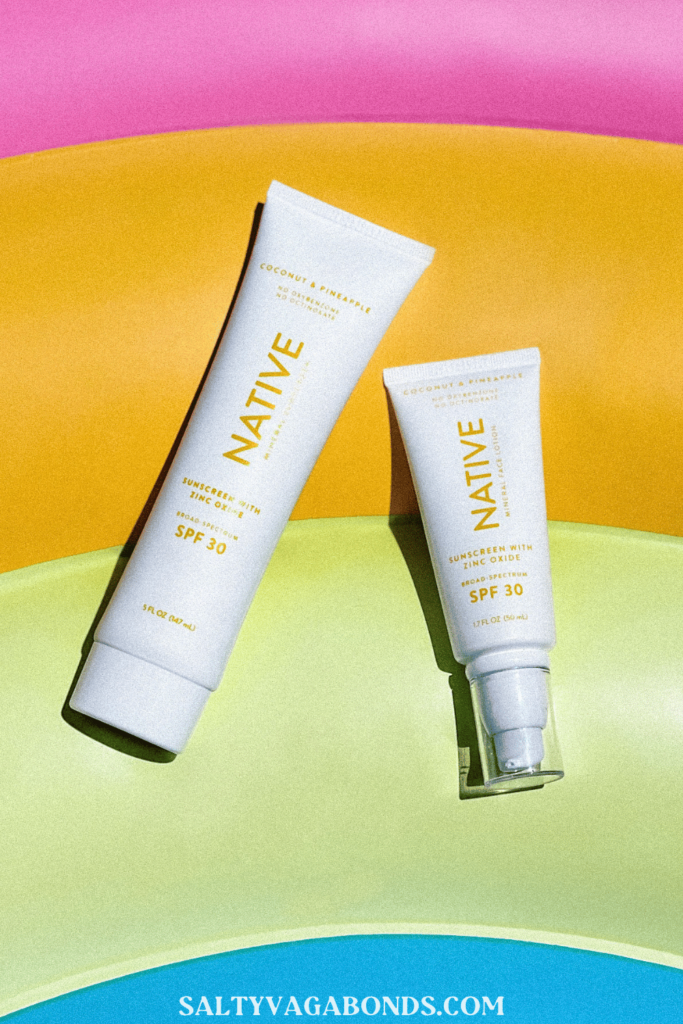
This sunscreen includes non-nano zinc oxide of 20%, vitamin E, avocado oil, coconut oil and sunflower seed oil to name a few. With these ingredients being vegan and cruelty free, it makes this sunscreen suitable for sensitive skin.
Raw Elements Natural Sunscreen
We have used lots of different sunscreens. We first picked this up in 2018 after seeing another sailing channel promote the product. Reef safe, water resistant and comes with toner in the sunscreen.
We have used Sunscreens in a wide range from Neutrogena, Sun Bum, Hawaiian Tropic and Alba. That list names a few of the sunscreens that we have used to the end of the bottle or more than halfway.

In the last few years living on a boat we have evolved into buying “reef safe” and “reef friendly”. “Reef friendly” and “reef safe” are still and can be harmful because these terms are not regulated by the sunscreen industry. You can start with those terms to narrow the search down. I found a good list on Open Water HQ of sunscreen chemical ingredients that you want to look for so you can stay away from those products.
We bought a face and body tin and two tinted face stick products from Raw Elements. The specs we do like, they are safe for the ocean and they are mineral-based sunscreens. The things we do not like is the cake like feeling of the sunscreen and that the face stick packaging is not biodegradable.
We try to find sunscreen products that are in biodegradable packaging so we can feel safe about losing it in the marine environment. But the best sunscreen that we love the most and that goes on light and smooth is Bare Republic. If they could get to a more sustainable packaging for the face stick it would be our top favorite. Raw Elements sunscreen is good and I have a tin that has been to 9 countries with me.
Bare Republic Mineral Sunscreen by Coola
We were in the Walmart in La Paz, Mexico grabbing groceries before we headed out for a few months on our boat to adventure through the Sea of Cortez. We looked at the mineral sunscreens and Bare Republic was on the shelf.
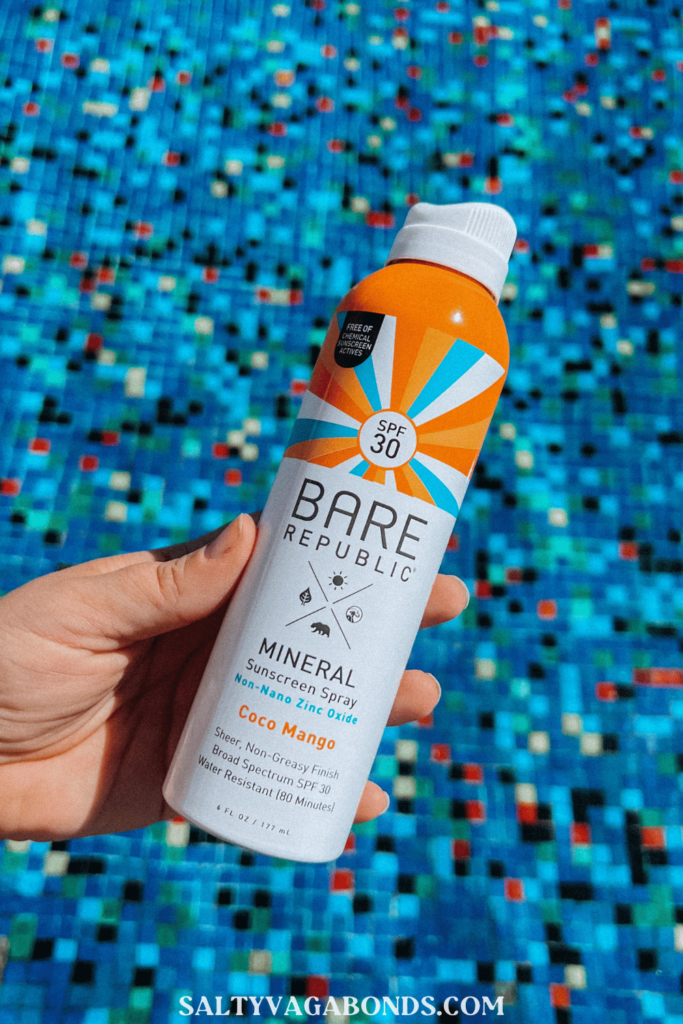
I looked at the Ingredient list and the active ingredients are titanium dioxide and zinc dioxide. We buy two of the 50 spf face sticks. We opened it and fell in love with this item because it applied smoothly and didn’t feel cakey at all. It also smelled really pleasing compared to your standard sunscreen.
After doing some light research I came across Chris Birchby bio. He is the founder of COOLA and Bare Republic. Chris’ journey to entrepreneurship began after both of his parents’ recovered from melanoma, which inspired him to help prevent skin cancer. He dove deeply into the world of organic skincare and sunscreen formulation.
Knowing that he is on a journey to provide the best there is, we bought more of his products while visiting the states.
Here’s what we have purchased
- 2 cans of the Mineral SPF 50 Sport Sunscreen Spray – Vanilla Coco,
- More of the 50spf face sticks
- 70 spf face stick in a teardrop formation
- 1 tube of the Mineral SPF 30 Metallic Shimmer Sunscreen Lotion – Golden Daze
We used everything up in the past year except the Golden Daze because Amanda loves it and wants to pick the best spots to wear it. It has glitter in it.
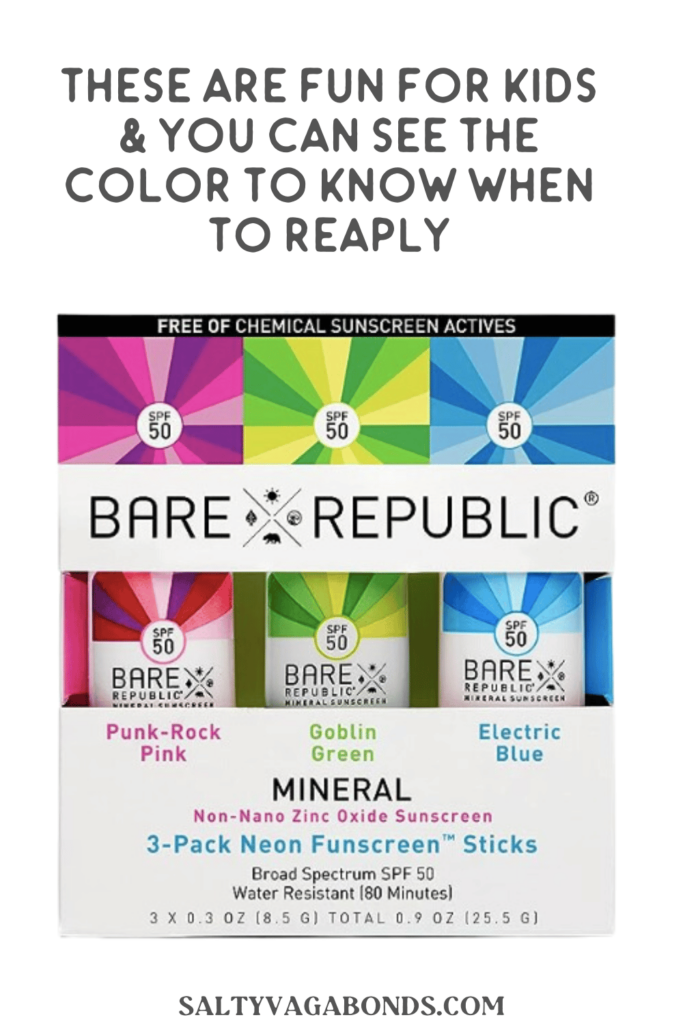
The teardrop shaped face stick is carried in our camera bag. Alex does long walks to capture photos and it being 70 proof helps when in the sun all day. The smell of the mineral spray cans are also very pleasing and keep you coming back. But the stick is just easy to have on you and very travel friendly.
We have not tried the Coola brand yet but it is on our list. Bare Republic is by far our favorite sunscreen brand that has many Hawaii reef-safe sunscreens.
Sunburn Recovery
After spending the day at the beach it is always a good idea to reapply sunscreen. If you don’t you will likely end up with a burn. It seems that mostly everyone reaches for Aloe Vera to help aid in their recovery. You would think most products sold in stores were legit Aloe Vera but they are not. Here are some insights about Aloe Vera products that you might not know.
Bloomberg conducted a study in 2016 and found that there was no aloe vera gel in major products found in big box stores. The culprits are Wal-Mart, CVS, Walgreens, Target and the household brands associated with those companies.
Shopping for legit Aloe Vera can be stressful. Some simple steps are to avoid purchasing from the big brands. Look for the smaller brands that say “100% organic”, “100% pure organic aloe juice/gel” and “100% pure Aloe Vera Gel”.
How to spot the real Aloe Vera versus the fake
Price is one way to find what is real and what is not real aloe vera. If the trendy Target brand aloe vera is $10 for a 16 ounce bottle and the other smaller brand Aloe is $10 for a 4 ounce bottle of sun relief gel you have found an imposter. The target brand is not real aloe not just because of price, but the price of the product is a big indicator.
If you have a sunburn there are other options that are very helpful for the burn. Lotions and oils are a great way to reintroduce moisture and repair elements back to the skin.
Aloe Vera Alternative
Blue Tansy Body Oil by Primally Pure is one of the best things we have found for our recovery. It has quickly become one of our favorite products. This oil is marketed as “the blue-hued component in blue tansy essential oil. It powerfully soothes irritated + inflamed skin and combats inflammation” on their website. (Primally Pure Face & Body, Get 10% off Here)
Surprisingly, blue tansy oil helps with pain and soreness. I have gotten a little too much sun a few times this year. However, when I apply this oil usually the next day the pain and redness are not there. It smells amazing and we love that Primally Pure is organic and a great trustworthy brand.
Final Thoughts
We hope this is helpful! If you’re looking for the best sunscreen for Hawaii to take on your next trip or if you’re already living in Hawaii… We hope you enjoyed learning our take on the sunblock products we love. These sunscreens have helped us stay eco friendly and ocean friendly.
Leave a Reply Cancel reply
You must be logged in to post a comment.
Our Story
Message in a
bottle?
Join our Newsletter! We're sharing monthly tips & tricks for travel, discounts & more.
Travel Blogs
About us
Contact
Tips & Tricks
hello@saltyvagabonds.com
Link in Bio
Work With Us
SpaceA Military Flights
Santa Fe Travel Guide
Visit Disney Aulani Hawaii
Family Packing Guide
Our Photography Gear
Plan Your Travel
See you soon!
Planning
Tips
Destinations
Oceania
North America
Europe
Asia
Bali
Japan
Korea
Malaysia
singapore
Thailand
Vietnam
France
U.K.
Germany
Canada
Mexico
usa
French Polynesia
Micronesia
Hawaii
Guam
Indonesia
All Travel Blogs
Destinations
Planning
Tips
Destinations
Travel Tips
Planning
About us
Hotels
via Booking.com
Car Rental
Book a Bus/Train/Transfer
Find Cheap Flights
Get ESIM or SIM Card
Easy Currency Exchange
Book Tours & Attractions
Get Travel Insurance
via Discover Cars
via Skyscanner
via 12Go
via Wise
via Viator
via Visitors Coverage
via SimOptions